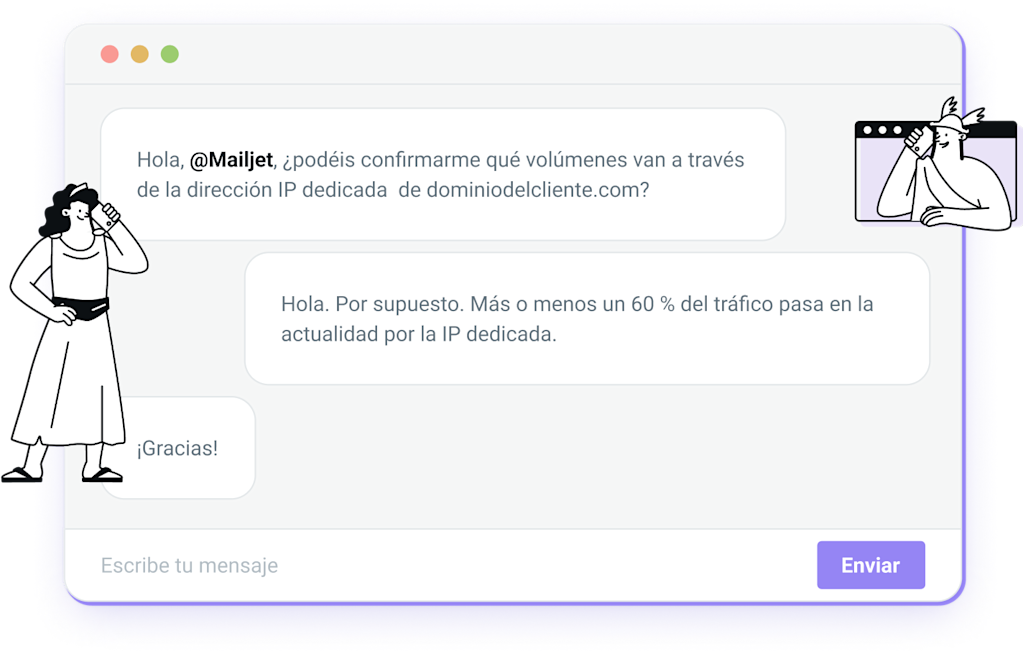Gestiona todos tus clientes en un solo lugar
Mantén el control total sobre el programa de emails de tu cliente. Mailjet le proporciona a las agencias:
Subcuentas para cada uno de tus clientes para que sus campañas estén separadas.
Webhooks para enviar estadísticas a tu equipo y clientes para supervisar el rendimiento.
Integraciones que te permiten utilizar tus propias herramientas para tus necesidades específicas o las de tus clientes.


Crea emails geniales en equipo
Agiliza tus operaciones, disminuyendo significativamente tanto el tiempo como el esfuerzo necesarios para ejecutar tus flujos de trabajo:
Utiliza la Colaboración en tiempo real para ver los cambios al instante y dejar comentarios a tu equipo.
Aplica el Kit de marca a tus emails para mantener la coherencia y garantizar que se utilicen los elementos de diseño correctos.
Prueba de forma proactiva tus correos utilizando la Previsualización de emails para asegurarte de que tu público ve tus emails como tú quieres.
Ofrece tu propia plataforma de email marketing
La solución de email marketing de Marca Blanca de Mailjet, totalmente personalizable, te permite ofrecer, sin complicaciones, un editor de emails personalizado para tu marca, bases de datos de contactos, gestión de plantillas y una infraestructura de envíos directamente con tu producto y servicio.

Un equipo de Technical Account Managers dedicado para agencias
Las agencias de email marketing que envían más de 900 000 emails/mes tienen a su disposición asistencia personalizada con nuestro equipo de expertos en agencias.
Nuestros Technical Account Managers trabajarán con tu equipo, ofreciéndoos todo lo necesario para que logréis alcanzar vuestros objetivos más ambiciosos: desde auditorías para evaluar las prácticas de tus clientes, onboarding y formación dedicada y soporte de entregabilidad, hasta la integración con nuestra API.

Onboarding e integración
Benefíciate de un proceso de onboarding personalizado que se adapte a tus necesidades y empieza a usar Mailjet como un experto.
Calentamiento de la IP
Configuración de cuentas secundarias
Configuración de dominios de envío
Formación
Mailjet ofrece formación para que la actividad de tus emails sea un éxito.
Entregabilidad: llega a la bandeja de entrada
Email marketing avanzado
Asistencia diaria
Recibe la asistencia de un Technical Account Manager dedicado que conoce tu cuenta, a tus clientes y tus problemas.
Llamadas telefónicas periódicas para llevar un seguimiento de la actividad de cada subcuenta
Creación de informes de entregabilidad diarios

“Nos decantamos por Mailjet por sus interfaces de usuario y la asistencia técnica en 4 idiomas que ofrece a nuestros clientes. Además, se ha adaptado rápidamente para cumplir con el RGPD, lo que ha venido a confirmar nuestra elección. Por último, la evolución de los servicios ofrecidos para las campañas y las transacciones hacen que sea posible seguir las principales tendencias del email de afinidad, además de abrir los servicios a herramientas externas (a través de una API). En resumen, Mailjet es hoy en día un servicio indispensable para la implementación de estrategias digitales.”
Kevin Gallot
CEO, Inflexia - Inflexia

